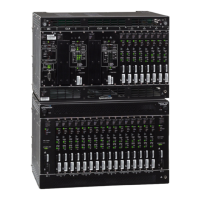142 097-55501-01 Issue 6 – June 2003
1
TimeHub 5500 System Guide
9 Set Bridged mode for enabled DS1 inputs, if needed. Generally, DS1 inputs connected to
TimeHub will be terminated at the input. However, if the reference signal is bridged (which
means it will be nominally 20 dB lower in amplitude), the bridged selection should be set
for any such input. The default setting is that bridged inputs are not expected for inputs 1 -
4.
To change bridged setting if using TimeScan THC:
Use the BRIDGED row on the Configuration -> Input screen to change the setting for any
appropriate inputs.
To change bridged setting if using terminal software, such as HyperTerminal, the TL1
general form for bridged setting is:
ED-SYNC::CLK-a:SV382:::BRIDGED=b;
Where a = 1 - 4 to identify the input whose bridged state is being set and b = Y for Bridged
expected, N for Bridged not expected (i.e., terminated).
To set input 1 to expect a bridged signal level, type and send:
ED-SYNC::CLK-1:SV385:::BRIDGED=Y;
The bridged setting for input 1 can be retrieved with:
RTRV-SYNC::CLK-1:SV386:::PARAMETER=BRIDGED;
10 Configure inputs to use SSM, if desired. If you have ESF-framed DS1 inputs providing
SSM messages that you want to use as part of the input qualification process, follow steps
10 and 11 to enable the SSM capability. The default is that SSM is not used for qualifying
inputs. If you do not want to use SSM for input qualification, skip to step 12.
If using TimeScan THC:
In the upper right of the Configuration -> Input screen, there is a section titled SSM
Support. Select SSM to use SSM as an input qualification criteria. Selecting Without SSM
will cause the TimeHub to not use SSM as a consideration for input qualification.
If using terminal software, such as HyperTerminal, to select SSM to be used as an input
qualification criteria, type and send:
ED-EQPT::CLK:SV41:::SYNCMDE=SSM;
Procedure 4-9. System Configuration (Cont’d)
Step Action

